The Impact of Job Satisfaction on Organisational Behaviour: An Essay
VerifiedAdded on 2020/10/04
|12
|3946
|284
Essay
AI Summary
This essay delves into the critical role of employee job satisfaction within the framework of organizational behavior. It highlights the significance of job satisfaction in reducing employee attrition rates, a key metric reflecting the health of a company's employment practices. The essay uses the example of Nestle to illustrate how providing employee perks and benefits can significantly lower attrition rates and foster a positive work environment. Furthermore, it explores how job satisfaction contributes to enhancing an organization's goodwill, brand image, and market value. The essay also emphasizes the importance of factors such as fair compensation, career development opportunities, and open communication networks in boosting employee morale and overall organizational success. The essay concludes by underscoring how employee satisfaction can positively influence sales, profitability, and the company's ability to attract and retain talent in a competitive market.

ORGANISATIONAL
BEHAVIOUR
BEHAVIOUR
Paraphrase This Document
Need a fresh take? Get an instant paraphrase of this document with our AI Paraphraser

Table of Contents
INTRODUCTION...........................................................................................................................1
MAIN BODY...................................................................................................................................1
CONCLUSION ...............................................................................................................................8
REFERENCES ...............................................................................................................................9
INTRODUCTION...........................................................................................................................1
MAIN BODY...................................................................................................................................1
CONCLUSION ...............................................................................................................................8
REFERENCES ...............................................................................................................................9
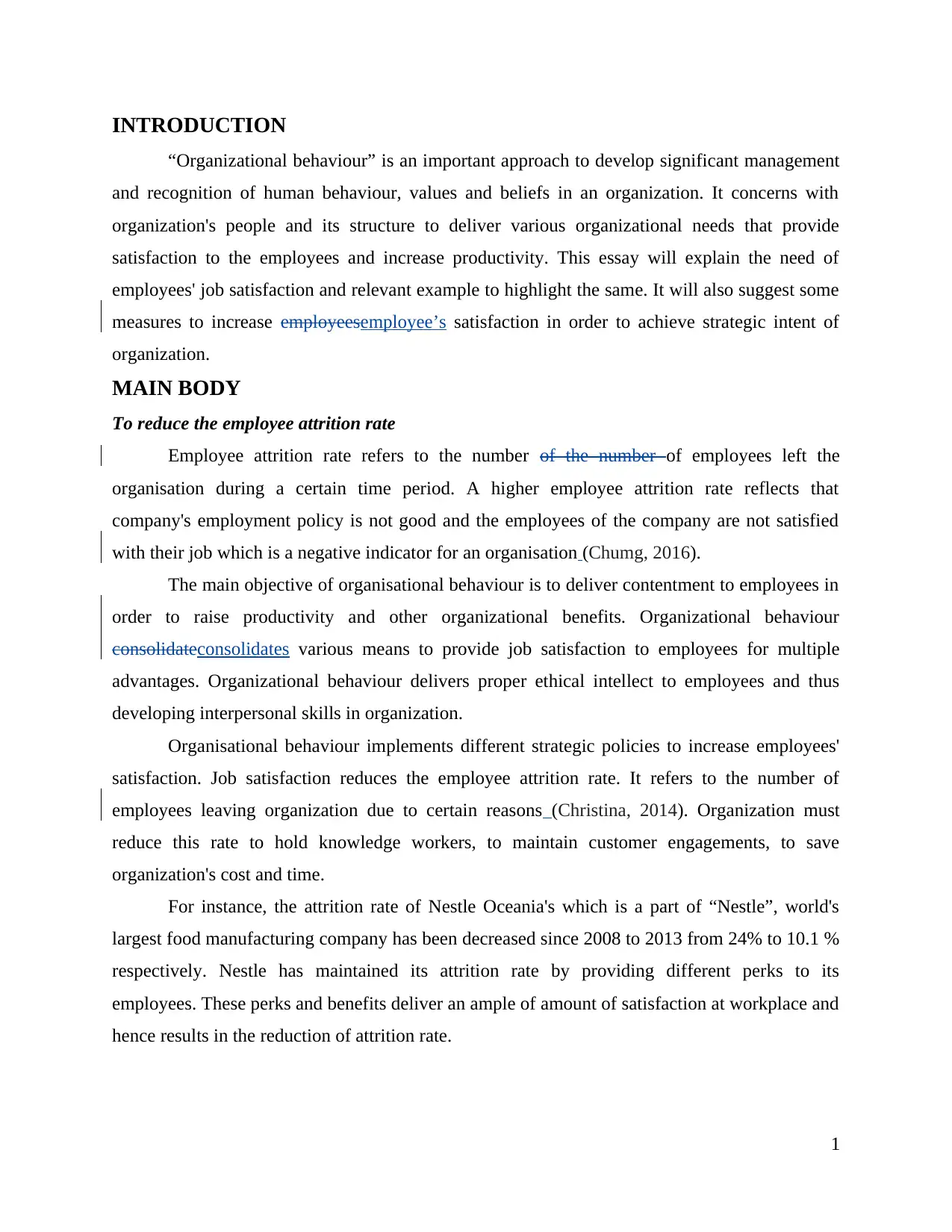
INTRODUCTION
“Organizational behaviour” is an important approach to develop significant management
and recognition of human behaviour, values and beliefs in an organization. It concerns with
organization's people and its structure to deliver various organizational needs that provide
satisfaction to the employees and increase productivity. This essay will explain the need of
employees' job satisfaction and relevant example to highlight the same. It will also suggest some
measures to increase employeesemployee’s satisfaction in order to achieve strategic intent of
organization.
MAIN BODY
To reduce the employee attrition rate
Employee attrition rate refers to the number of the number of employees left the
organisation during a certain time period. A higher employee attrition rate reflects that
company's employment policy is not good and the employees of the company are not satisfied
with their job which is a negative indicator for an organisation (Chumg, 2016).
The main objective of organisational behaviour is to deliver contentment to employees in
order to raise productivity and other organizational benefits. Organizational behaviour
consolidateconsolidates various means to provide job satisfaction to employees for multiple
advantages. Organizational behaviour delivers proper ethical intellect to employees and thus
developing interpersonal skills in organization.
Organisational behaviour implements different strategic policies to increase employees'
satisfaction. Job satisfaction reduces the employee attrition rate. It refers to the number of
employees leaving organization due to certain reasons (Christina, 2014). Organization must
reduce this rate to hold knowledge workers, to maintain customer engagements, to save
organization's cost and time.
For instance, the attrition rate of Nestle Oceania's which is a part of “Nestle”, world's
largest food manufacturing company has been decreased since 2008 to 2013 from 24% to 10.1 %
respectively. Nestle has maintained its attrition rate by providing different perks to its
employees. These perks and benefits deliver an ample of amount of satisfaction at workplace and
hence results in the reduction of attrition rate.
1
“Organizational behaviour” is an important approach to develop significant management
and recognition of human behaviour, values and beliefs in an organization. It concerns with
organization's people and its structure to deliver various organizational needs that provide
satisfaction to the employees and increase productivity. This essay will explain the need of
employees' job satisfaction and relevant example to highlight the same. It will also suggest some
measures to increase employeesemployee’s satisfaction in order to achieve strategic intent of
organization.
MAIN BODY
To reduce the employee attrition rate
Employee attrition rate refers to the number of the number of employees left the
organisation during a certain time period. A higher employee attrition rate reflects that
company's employment policy is not good and the employees of the company are not satisfied
with their job which is a negative indicator for an organisation (Chumg, 2016).
The main objective of organisational behaviour is to deliver contentment to employees in
order to raise productivity and other organizational benefits. Organizational behaviour
consolidateconsolidates various means to provide job satisfaction to employees for multiple
advantages. Organizational behaviour delivers proper ethical intellect to employees and thus
developing interpersonal skills in organization.
Organisational behaviour implements different strategic policies to increase employees'
satisfaction. Job satisfaction reduces the employee attrition rate. It refers to the number of
employees leaving organization due to certain reasons (Christina, 2014). Organization must
reduce this rate to hold knowledge workers, to maintain customer engagements, to save
organization's cost and time.
For instance, the attrition rate of Nestle Oceania's which is a part of “Nestle”, world's
largest food manufacturing company has been decreased since 2008 to 2013 from 24% to 10.1 %
respectively. Nestle has maintained its attrition rate by providing different perks to its
employees. These perks and benefits deliver an ample of amount of satisfaction at workplace and
hence results in the reduction of attrition rate.
1
⊘ This is a preview!⊘
Do you want full access?
Subscribe today to unlock all pages.

Trusted by 1+ million students worldwide
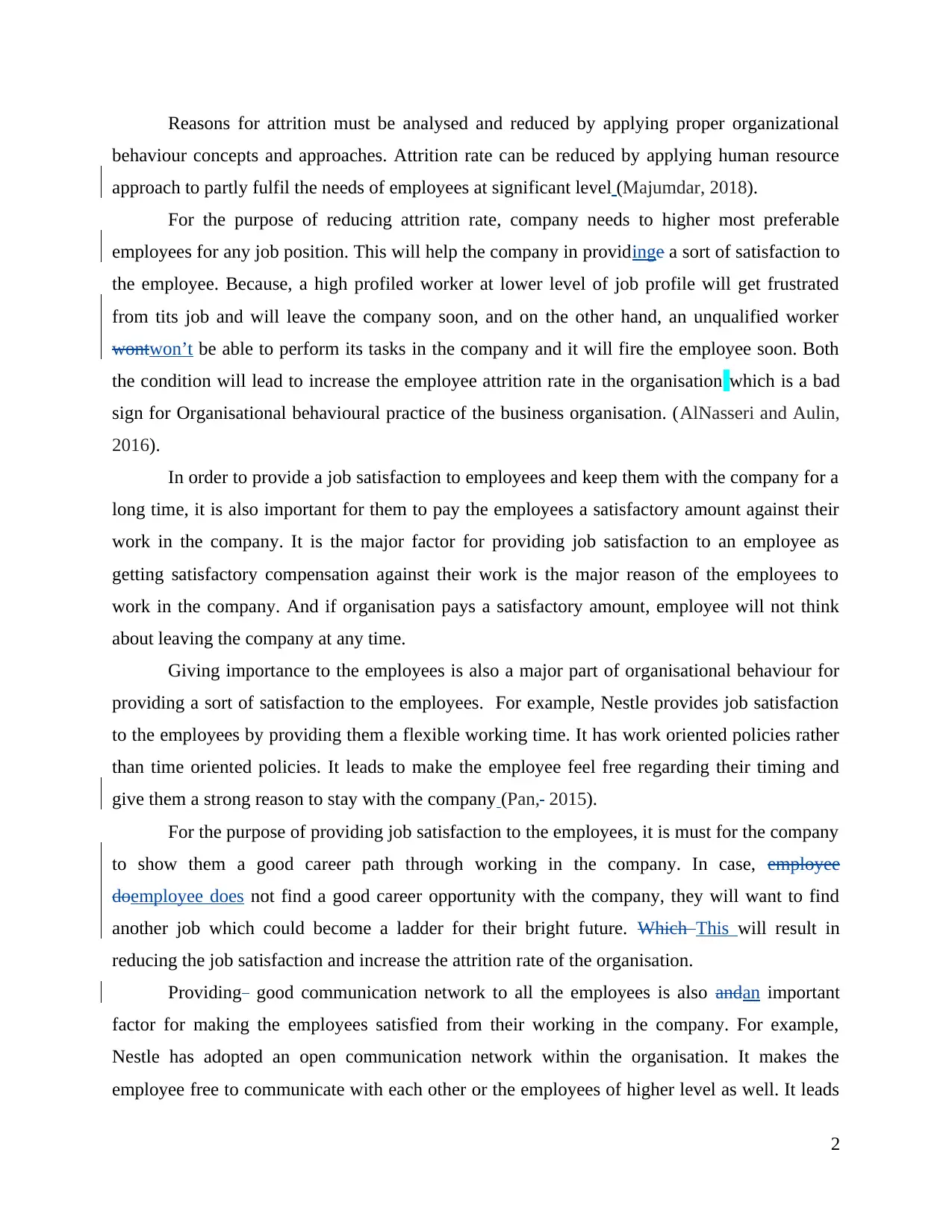
Reasons for attrition must be analysed and reduced by applying proper organizational
behaviour concepts and approaches. Attrition rate can be reduced by applying human resource
approach to partly fulfil the needs of employees at significant level (Majumdar, 2018).
For the purpose of reducing attrition rate, company needs to higher most preferable
employees for any job position. This will help the company in providinge a sort of satisfaction to
the employee. Because, a high profiled worker at lower level of job profile will get frustrated
from tits job and will leave the company soon, and on the other hand, an unqualified worker
wontwon’t be able to perform its tasks in the company and it will fire the employee soon. Both
the condition will lead to increase the employee attrition rate in the organisation which is a bad
sign for Organisational behavioural practice of the business organisation. (AlNasseri and Aulin,
2016).
In order to provide a job satisfaction to employees and keep them with the company for a
long time, it is also important for them to pay the employees a satisfactory amount against their
work in the company. It is the major factor for providing job satisfaction to an employee as
getting satisfactory compensation against their work is the major reason of the employees to
work in the company. And if organisation pays a satisfactory amount, employee will not think
about leaving the company at any time.
Giving importance to the employees is also a major part of organisational behaviour for
providing a sort of satisfaction to the employees. For example, Nestle provides job satisfaction
to the employees by providing them a flexible working time. It has work oriented policies rather
than time oriented policies. It leads to make the employee feel free regarding their timing and
give them a strong reason to stay with the company (Pan, 2015).
For the purpose of providing job satisfaction to the employees, it is must for the company
to show them a good career path through working in the company. In case, employee
doemployee does not find a good career opportunity with the company, they will want to find
another job which could become a ladder for their bright future. Which This will result in
reducing the job satisfaction and increase the attrition rate of the organisation.
Providing good communication network to all the employees is also andan important
factor for making the employees satisfied from their working in the company. For example,
Nestle has adopted an open communication network within the organisation. It makes the
employee free to communicate with each other or the employees of higher level as well. It leads
2
behaviour concepts and approaches. Attrition rate can be reduced by applying human resource
approach to partly fulfil the needs of employees at significant level (Majumdar, 2018).
For the purpose of reducing attrition rate, company needs to higher most preferable
employees for any job position. This will help the company in providinge a sort of satisfaction to
the employee. Because, a high profiled worker at lower level of job profile will get frustrated
from tits job and will leave the company soon, and on the other hand, an unqualified worker
wontwon’t be able to perform its tasks in the company and it will fire the employee soon. Both
the condition will lead to increase the employee attrition rate in the organisation which is a bad
sign for Organisational behavioural practice of the business organisation. (AlNasseri and Aulin,
2016).
In order to provide a job satisfaction to employees and keep them with the company for a
long time, it is also important for them to pay the employees a satisfactory amount against their
work in the company. It is the major factor for providing job satisfaction to an employee as
getting satisfactory compensation against their work is the major reason of the employees to
work in the company. And if organisation pays a satisfactory amount, employee will not think
about leaving the company at any time.
Giving importance to the employees is also a major part of organisational behaviour for
providing a sort of satisfaction to the employees. For example, Nestle provides job satisfaction
to the employees by providing them a flexible working time. It has work oriented policies rather
than time oriented policies. It leads to make the employee feel free regarding their timing and
give them a strong reason to stay with the company (Pan, 2015).
For the purpose of providing job satisfaction to the employees, it is must for the company
to show them a good career path through working in the company. In case, employee
doemployee does not find a good career opportunity with the company, they will want to find
another job which could become a ladder for their bright future. Which This will result in
reducing the job satisfaction and increase the attrition rate of the organisation.
Providing good communication network to all the employees is also andan important
factor for making the employees satisfied from their working in the company. For example,
Nestle has adopted an open communication network within the organisation. It makes the
employee free to communicate with each other or the employees of higher level as well. It leads
2
Paraphrase This Document
Need a fresh take? Get an instant paraphrase of this document with our AI Paraphraser
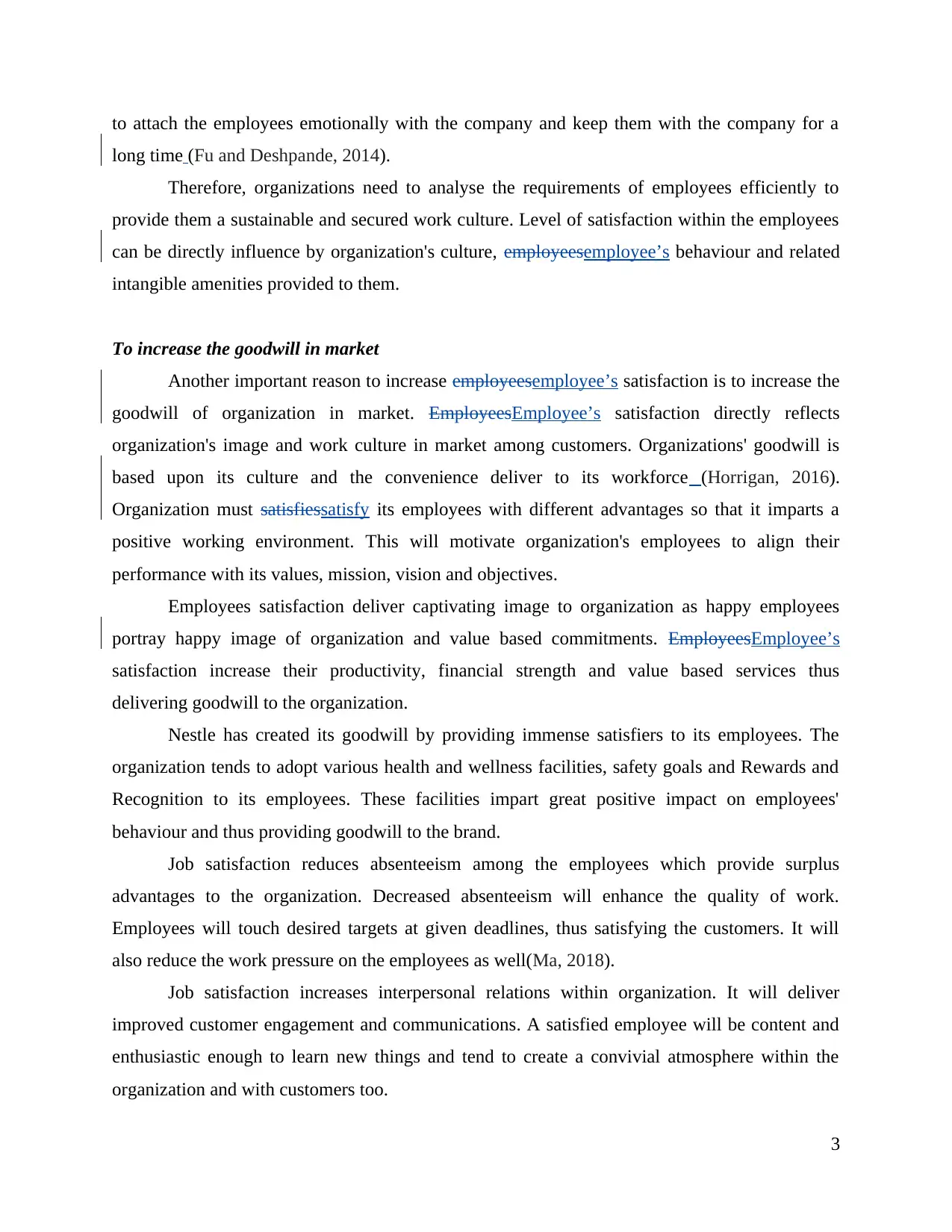
to attach the employees emotionally with the company and keep them with the company for a
long time (Fu and Deshpande, 2014).
Therefore, organizations need to analyse the requirements of employees efficiently to
provide them a sustainable and secured work culture. Level of satisfaction within the employees
can be directly influence by organization's culture, employeesemployee’s behaviour and related
intangible amenities provided to them.
To increase the goodwill in market
Another important reason to increase employeesemployee’s satisfaction is to increase the
goodwill of organization in market. EmployeesEmployee’s satisfaction directly reflects
organization's image and work culture in market among customers. Organizations' goodwill is
based upon its culture and the convenience deliver to its workforce (Horrigan, 2016).
Organization must satisfiessatisfy its employees with different advantages so that it imparts a
positive working environment. This will motivate organization's employees to align their
performance with its values, mission, vision and objectives.
Employees satisfaction deliver captivating image to organization as happy employees
portray happy image of organization and value based commitments. EmployeesEmployee’s
satisfaction increase their productivity, financial strength and value based services thus
delivering goodwill to the organization.
Nestle has created its goodwill by providing immense satisfiers to its employees. The
organization tends to adopt various health and wellness facilities, safety goals and Rewards and
Recognition to its employees. These facilities impart great positive impact on employees'
behaviour and thus providing goodwill to the brand.
Job satisfaction reduces absenteeism among the employees which provide surplus
advantages to the organization. Decreased absenteeism will enhance the quality of work.
Employees will touch desired targets at given deadlines, thus satisfying the customers. It will
also reduce the work pressure on the employees as well(Ma, 2018).
Job satisfaction increases interpersonal relations within organization. It will deliver
improved customer engagement and communications. A satisfied employee will be content and
enthusiastic enough to learn new things and tend to create a convivial atmosphere within the
organization and with customers too.
3
long time (Fu and Deshpande, 2014).
Therefore, organizations need to analyse the requirements of employees efficiently to
provide them a sustainable and secured work culture. Level of satisfaction within the employees
can be directly influence by organization's culture, employeesemployee’s behaviour and related
intangible amenities provided to them.
To increase the goodwill in market
Another important reason to increase employeesemployee’s satisfaction is to increase the
goodwill of organization in market. EmployeesEmployee’s satisfaction directly reflects
organization's image and work culture in market among customers. Organizations' goodwill is
based upon its culture and the convenience deliver to its workforce (Horrigan, 2016).
Organization must satisfiessatisfy its employees with different advantages so that it imparts a
positive working environment. This will motivate organization's employees to align their
performance with its values, mission, vision and objectives.
Employees satisfaction deliver captivating image to organization as happy employees
portray happy image of organization and value based commitments. EmployeesEmployee’s
satisfaction increase their productivity, financial strength and value based services thus
delivering goodwill to the organization.
Nestle has created its goodwill by providing immense satisfiers to its employees. The
organization tends to adopt various health and wellness facilities, safety goals and Rewards and
Recognition to its employees. These facilities impart great positive impact on employees'
behaviour and thus providing goodwill to the brand.
Job satisfaction reduces absenteeism among the employees which provide surplus
advantages to the organization. Decreased absenteeism will enhance the quality of work.
Employees will touch desired targets at given deadlines, thus satisfying the customers. It will
also reduce the work pressure on the employees as well(Ma, 2018).
Job satisfaction increases interpersonal relations within organization. It will deliver
improved customer engagement and communications. A satisfied employee will be content and
enthusiastic enough to learn new things and tend to create a convivial atmosphere within the
organization and with customers too.
3
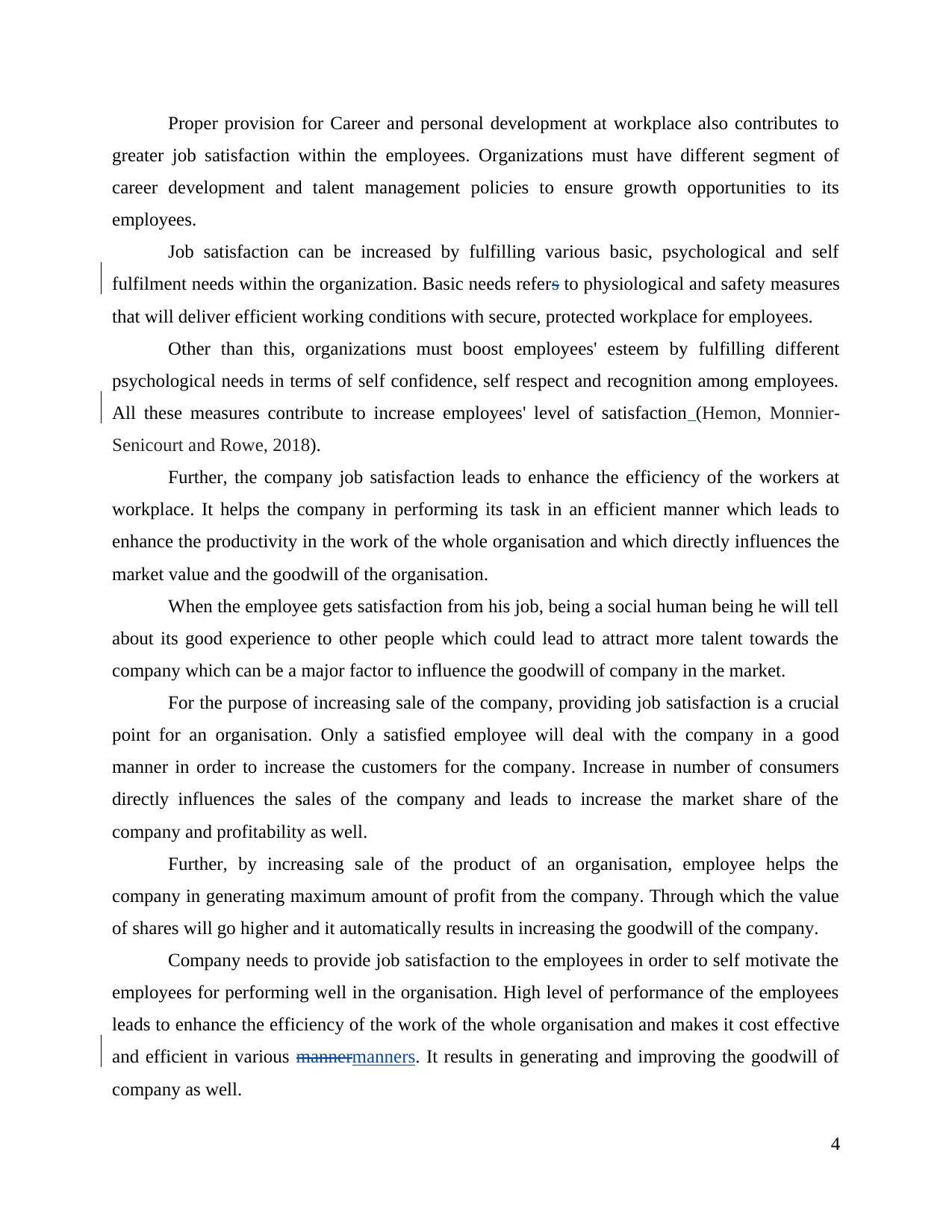
Proper provision for Career and personal development at workplace also contributes to
greater job satisfaction within the employees. Organizations must have different segment of
career development and talent management policies to ensure growth opportunities to its
employees.
Job satisfaction can be increased by fulfilling various basic, psychological and self
fulfilment needs within the organization. Basic needs refers to physiological and safety measures
that will deliver efficient working conditions with secure, protected workplace for employees.
Other than this, organizations must boost employees' esteem by fulfilling different
psychological needs in terms of self confidence, self respect and recognition among employees.
All these measures contribute to increase employees' level of satisfaction (Hemon, Monnier-
Senicourt and Rowe, 2018).
Further, the company job satisfaction leads to enhance the efficiency of the workers at
workplace. It helps the company in performing its task in an efficient manner which leads to
enhance the productivity in the work of the whole organisation and which directly influences the
market value and the goodwill of the organisation.
When the employee gets satisfaction from his job, being a social human being he will tell
about its good experience to other people which could lead to attract more talent towards the
company which can be a major factor to influence the goodwill of company in the market.
For the purpose of increasing sale of the company, providing job satisfaction is a crucial
point for an organisation. Only a satisfied employee will deal with the company in a good
manner in order to increase the customers for the company. Increase in number of consumers
directly influences the sales of the company and leads to increase the market share of the
company and profitability as well.
Further, by increasing sale of the product of an organisation, employee helps the
company in generating maximum amount of profit from the company. Through which the value
of shares will go higher and it automatically results in increasing the goodwill of the company.
Company needs to provide job satisfaction to the employees in order to self motivate the
employees for performing well in the organisation. High level of performance of the employees
leads to enhance the efficiency of the work of the whole organisation and makes it cost effective
and efficient in various mannermanners. It results in generating and improving the goodwill of
company as well.
4
greater job satisfaction within the employees. Organizations must have different segment of
career development and talent management policies to ensure growth opportunities to its
employees.
Job satisfaction can be increased by fulfilling various basic, psychological and self
fulfilment needs within the organization. Basic needs refers to physiological and safety measures
that will deliver efficient working conditions with secure, protected workplace for employees.
Other than this, organizations must boost employees' esteem by fulfilling different
psychological needs in terms of self confidence, self respect and recognition among employees.
All these measures contribute to increase employees' level of satisfaction (Hemon, Monnier-
Senicourt and Rowe, 2018).
Further, the company job satisfaction leads to enhance the efficiency of the workers at
workplace. It helps the company in performing its task in an efficient manner which leads to
enhance the productivity in the work of the whole organisation and which directly influences the
market value and the goodwill of the organisation.
When the employee gets satisfaction from his job, being a social human being he will tell
about its good experience to other people which could lead to attract more talent towards the
company which can be a major factor to influence the goodwill of company in the market.
For the purpose of increasing sale of the company, providing job satisfaction is a crucial
point for an organisation. Only a satisfied employee will deal with the company in a good
manner in order to increase the customers for the company. Increase in number of consumers
directly influences the sales of the company and leads to increase the market share of the
company and profitability as well.
Further, by increasing sale of the product of an organisation, employee helps the
company in generating maximum amount of profit from the company. Through which the value
of shares will go higher and it automatically results in increasing the goodwill of the company.
Company needs to provide job satisfaction to the employees in order to self motivate the
employees for performing well in the organisation. High level of performance of the employees
leads to enhance the efficiency of the work of the whole organisation and makes it cost effective
and efficient in various mannermanners. It results in generating and improving the goodwill of
company as well.
4
⊘ This is a preview!⊘
Do you want full access?
Subscribe today to unlock all pages.

Trusted by 1+ million students worldwide
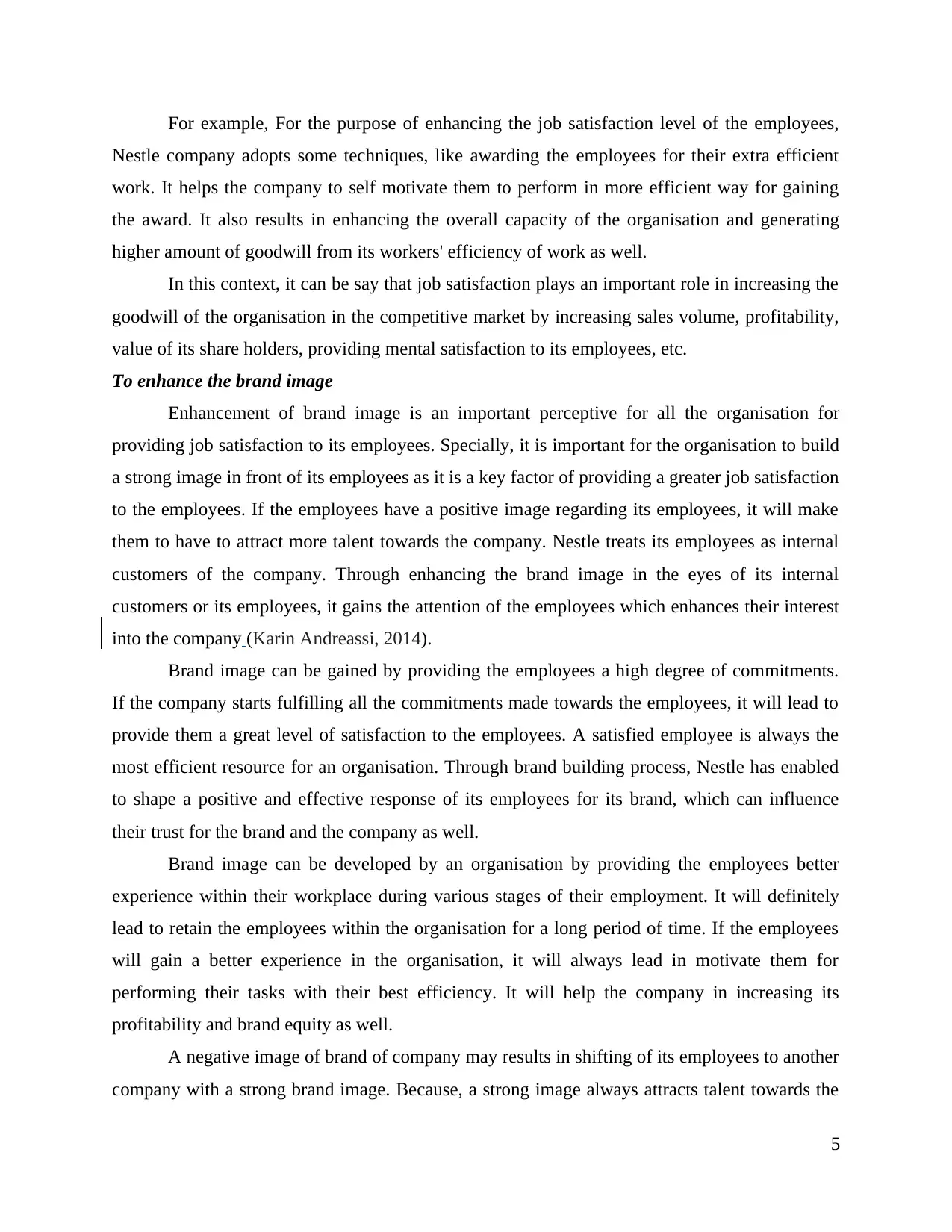
For example, For the purpose of enhancing the job satisfaction level of the employees,
Nestle company adopts some techniques, like awarding the employees for their extra efficient
work. It helps the company to self motivate them to perform in more efficient way for gaining
the award. It also results in enhancing the overall capacity of the organisation and generating
higher amount of goodwill from its workers' efficiency of work as well.
In this context, it can be say that job satisfaction plays an important role in increasing the
goodwill of the organisation in the competitive market by increasing sales volume, profitability,
value of its share holders, providing mental satisfaction to its employees, etc.
To enhance the brand image
Enhancement of brand image is an important perceptive for all the organisation for
providing job satisfaction to its employees. Specially, it is important for the organisation to build
a strong image in front of its employees as it is a key factor of providing a greater job satisfaction
to the employees. If the employees have a positive image regarding its employees, it will make
them to have to attract more talent towards the company. Nestle treats its employees as internal
customers of the company. Through enhancing the brand image in the eyes of its internal
customers or its employees, it gains the attention of the employees which enhances their interest
into the company (Karin Andreassi, 2014).
Brand image can be gained by providing the employees a high degree of commitments.
If the company starts fulfilling all the commitments made towards the employees, it will lead to
provide them a great level of satisfaction to the employees. A satisfied employee is always the
most efficient resource for an organisation. Through brand building process, Nestle has enabled
to shape a positive and effective response of its employees for its brand, which can influence
their trust for the brand and the company as well.
Brand image can be developed by an organisation by providing the employees better
experience within their workplace during various stages of their employment. It will definitely
lead to retain the employees within the organisation for a long period of time. If the employees
will gain a better experience in the organisation, it will always lead in motivate them for
performing their tasks with their best efficiency. It will help the company in increasing its
profitability and brand equity as well.
A negative image of brand of company may results in shifting of its employees to another
company with a strong brand image. Because, a strong image always attracts talent towards the
5
Nestle company adopts some techniques, like awarding the employees for their extra efficient
work. It helps the company to self motivate them to perform in more efficient way for gaining
the award. It also results in enhancing the overall capacity of the organisation and generating
higher amount of goodwill from its workers' efficiency of work as well.
In this context, it can be say that job satisfaction plays an important role in increasing the
goodwill of the organisation in the competitive market by increasing sales volume, profitability,
value of its share holders, providing mental satisfaction to its employees, etc.
To enhance the brand image
Enhancement of brand image is an important perceptive for all the organisation for
providing job satisfaction to its employees. Specially, it is important for the organisation to build
a strong image in front of its employees as it is a key factor of providing a greater job satisfaction
to the employees. If the employees have a positive image regarding its employees, it will make
them to have to attract more talent towards the company. Nestle treats its employees as internal
customers of the company. Through enhancing the brand image in the eyes of its internal
customers or its employees, it gains the attention of the employees which enhances their interest
into the company (Karin Andreassi, 2014).
Brand image can be gained by providing the employees a high degree of commitments.
If the company starts fulfilling all the commitments made towards the employees, it will lead to
provide them a great level of satisfaction to the employees. A satisfied employee is always the
most efficient resource for an organisation. Through brand building process, Nestle has enabled
to shape a positive and effective response of its employees for its brand, which can influence
their trust for the brand and the company as well.
Brand image can be developed by an organisation by providing the employees better
experience within their workplace during various stages of their employment. It will definitely
lead to retain the employees within the organisation for a long period of time. If the employees
will gain a better experience in the organisation, it will always lead in motivate them for
performing their tasks with their best efficiency. It will help the company in increasing its
profitability and brand equity as well.
A negative image of brand of company may results in shifting of its employees to another
company with a strong brand image. Because, a strong image always attracts talent towards the
5
Paraphrase This Document
Need a fresh take? Get an instant paraphrase of this document with our AI Paraphraser
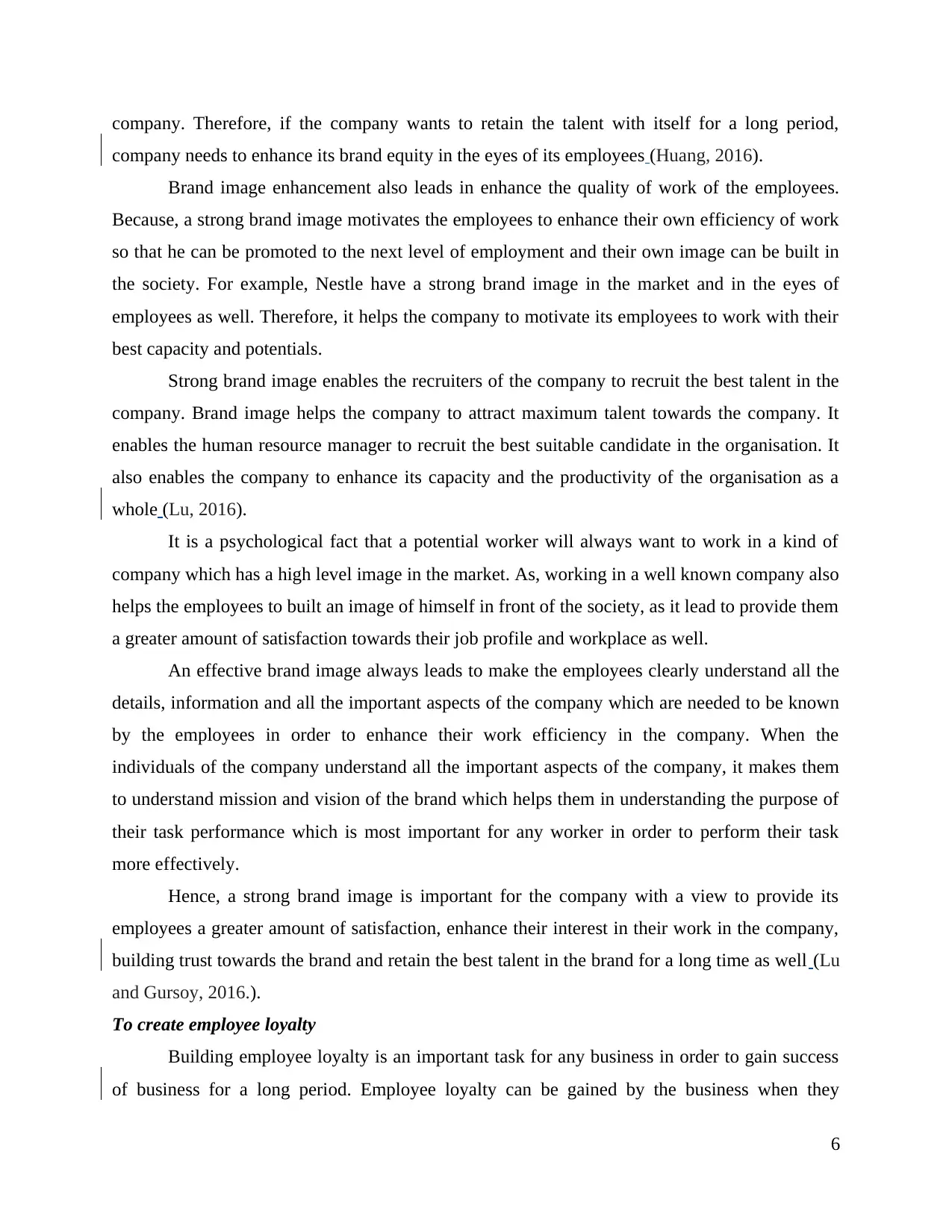
company. Therefore, if the company wants to retain the talent with itself for a long period,
company needs to enhance its brand equity in the eyes of its employees (Huang, 2016).
Brand image enhancement also leads in enhance the quality of work of the employees.
Because, a strong brand image motivates the employees to enhance their own efficiency of work
so that he can be promoted to the next level of employment and their own image can be built in
the society. For example, Nestle have a strong brand image in the market and in the eyes of
employees as well. Therefore, it helps the company to motivate its employees to work with their
best capacity and potentials.
Strong brand image enables the recruiters of the company to recruit the best talent in the
company. Brand image helps the company to attract maximum talent towards the company. It
enables the human resource manager to recruit the best suitable candidate in the organisation. It
also enables the company to enhance its capacity and the productivity of the organisation as a
whole (Lu, 2016).
It is a psychological fact that a potential worker will always want to work in a kind of
company which has a high level image in the market. As, working in a well known company also
helps the employees to built an image of himself in front of the society, as it lead to provide them
a greater amount of satisfaction towards their job profile and workplace as well.
An effective brand image always leads to make the employees clearly understand all the
details, information and all the important aspects of the company which are needed to be known
by the employees in order to enhance their work efficiency in the company. When the
individuals of the company understand all the important aspects of the company, it makes them
to understand mission and vision of the brand which helps them in understanding the purpose of
their task performance which is most important for any worker in order to perform their task
more effectively.
Hence, a strong brand image is important for the company with a view to provide its
employees a greater amount of satisfaction, enhance their interest in their work in the company,
building trust towards the brand and retain the best talent in the brand for a long time as well (Lu
and Gursoy, 2016.).
To create employee loyalty
Building employee loyalty is an important task for any business in order to gain success
of business for a long period. Employee loyalty can be gained by the business when they
6
company needs to enhance its brand equity in the eyes of its employees (Huang, 2016).
Brand image enhancement also leads in enhance the quality of work of the employees.
Because, a strong brand image motivates the employees to enhance their own efficiency of work
so that he can be promoted to the next level of employment and their own image can be built in
the society. For example, Nestle have a strong brand image in the market and in the eyes of
employees as well. Therefore, it helps the company to motivate its employees to work with their
best capacity and potentials.
Strong brand image enables the recruiters of the company to recruit the best talent in the
company. Brand image helps the company to attract maximum talent towards the company. It
enables the human resource manager to recruit the best suitable candidate in the organisation. It
also enables the company to enhance its capacity and the productivity of the organisation as a
whole (Lu, 2016).
It is a psychological fact that a potential worker will always want to work in a kind of
company which has a high level image in the market. As, working in a well known company also
helps the employees to built an image of himself in front of the society, as it lead to provide them
a greater amount of satisfaction towards their job profile and workplace as well.
An effective brand image always leads to make the employees clearly understand all the
details, information and all the important aspects of the company which are needed to be known
by the employees in order to enhance their work efficiency in the company. When the
individuals of the company understand all the important aspects of the company, it makes them
to understand mission and vision of the brand which helps them in understanding the purpose of
their task performance which is most important for any worker in order to perform their task
more effectively.
Hence, a strong brand image is important for the company with a view to provide its
employees a greater amount of satisfaction, enhance their interest in their work in the company,
building trust towards the brand and retain the best talent in the brand for a long time as well (Lu
and Gursoy, 2016.).
To create employee loyalty
Building employee loyalty is an important task for any business in order to gain success
of business for a long period. Employee loyalty can be gained by the business when they
6
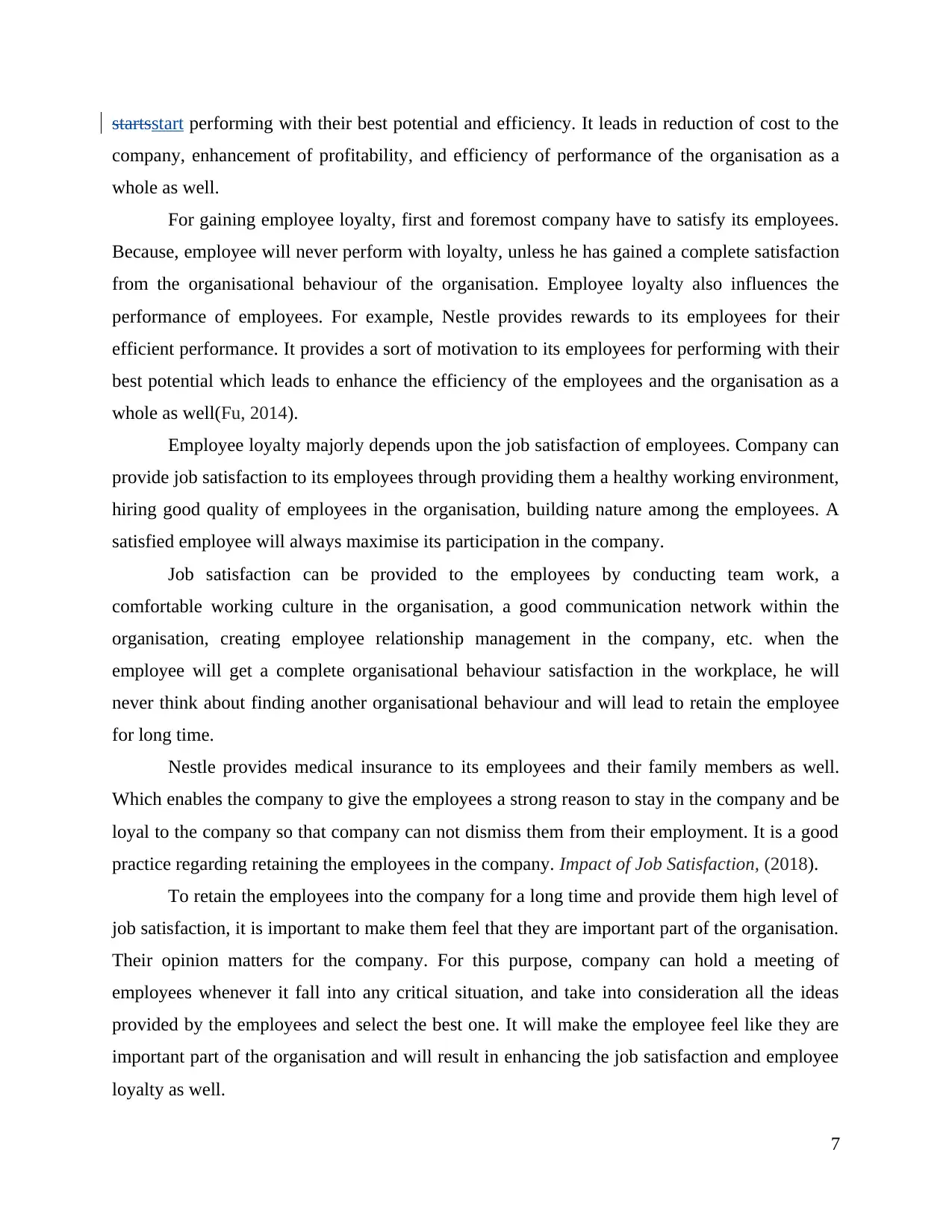
startsstart performing with their best potential and efficiency. It leads in reduction of cost to the
company, enhancement of profitability, and efficiency of performance of the organisation as a
whole as well.
For gaining employee loyalty, first and foremost company have to satisfy its employees.
Because, employee will never perform with loyalty, unless he has gained a complete satisfaction
from the organisational behaviour of the organisation. Employee loyalty also influences the
performance of employees. For example, Nestle provides rewards to its employees for their
efficient performance. It provides a sort of motivation to its employees for performing with their
best potential which leads to enhance the efficiency of the employees and the organisation as a
whole as well(Fu, 2014).
Employee loyalty majorly depends upon the job satisfaction of employees. Company can
provide job satisfaction to its employees through providing them a healthy working environment,
hiring good quality of employees in the organisation, building nature among the employees. A
satisfied employee will always maximise its participation in the company.
Job satisfaction can be provided to the employees by conducting team work, a
comfortable working culture in the organisation, a good communication network within the
organisation, creating employee relationship management in the company, etc. when the
employee will get a complete organisational behaviour satisfaction in the workplace, he will
never think about finding another organisational behaviour and will lead to retain the employee
for long time.
Nestle provides medical insurance to its employees and their family members as well.
Which enables the company to give the employees a strong reason to stay in the company and be
loyal to the company so that company can not dismiss them from their employment. It is a good
practice regarding retaining the employees in the company. Impact of Job Satisfaction, (2018).
To retain the employees into the company for a long time and provide them high level of
job satisfaction, it is important to make them feel that they are important part of the organisation.
Their opinion matters for the company. For this purpose, company can hold a meeting of
employees whenever it fall into any critical situation, and take into consideration all the ideas
provided by the employees and select the best one. It will make the employee feel like they are
important part of the organisation and will result in enhancing the job satisfaction and employee
loyalty as well.
7
company, enhancement of profitability, and efficiency of performance of the organisation as a
whole as well.
For gaining employee loyalty, first and foremost company have to satisfy its employees.
Because, employee will never perform with loyalty, unless he has gained a complete satisfaction
from the organisational behaviour of the organisation. Employee loyalty also influences the
performance of employees. For example, Nestle provides rewards to its employees for their
efficient performance. It provides a sort of motivation to its employees for performing with their
best potential which leads to enhance the efficiency of the employees and the organisation as a
whole as well(Fu, 2014).
Employee loyalty majorly depends upon the job satisfaction of employees. Company can
provide job satisfaction to its employees through providing them a healthy working environment,
hiring good quality of employees in the organisation, building nature among the employees. A
satisfied employee will always maximise its participation in the company.
Job satisfaction can be provided to the employees by conducting team work, a
comfortable working culture in the organisation, a good communication network within the
organisation, creating employee relationship management in the company, etc. when the
employee will get a complete organisational behaviour satisfaction in the workplace, he will
never think about finding another organisational behaviour and will lead to retain the employee
for long time.
Nestle provides medical insurance to its employees and their family members as well.
Which enables the company to give the employees a strong reason to stay in the company and be
loyal to the company so that company can not dismiss them from their employment. It is a good
practice regarding retaining the employees in the company. Impact of Job Satisfaction, (2018).
To retain the employees into the company for a long time and provide them high level of
job satisfaction, it is important to make them feel that they are important part of the organisation.
Their opinion matters for the company. For this purpose, company can hold a meeting of
employees whenever it fall into any critical situation, and take into consideration all the ideas
provided by the employees and select the best one. It will make the employee feel like they are
important part of the organisation and will result in enhancing the job satisfaction and employee
loyalty as well.
7
⊘ This is a preview!⊘
Do you want full access?
Subscribe today to unlock all pages.

Trusted by 1+ million students worldwide
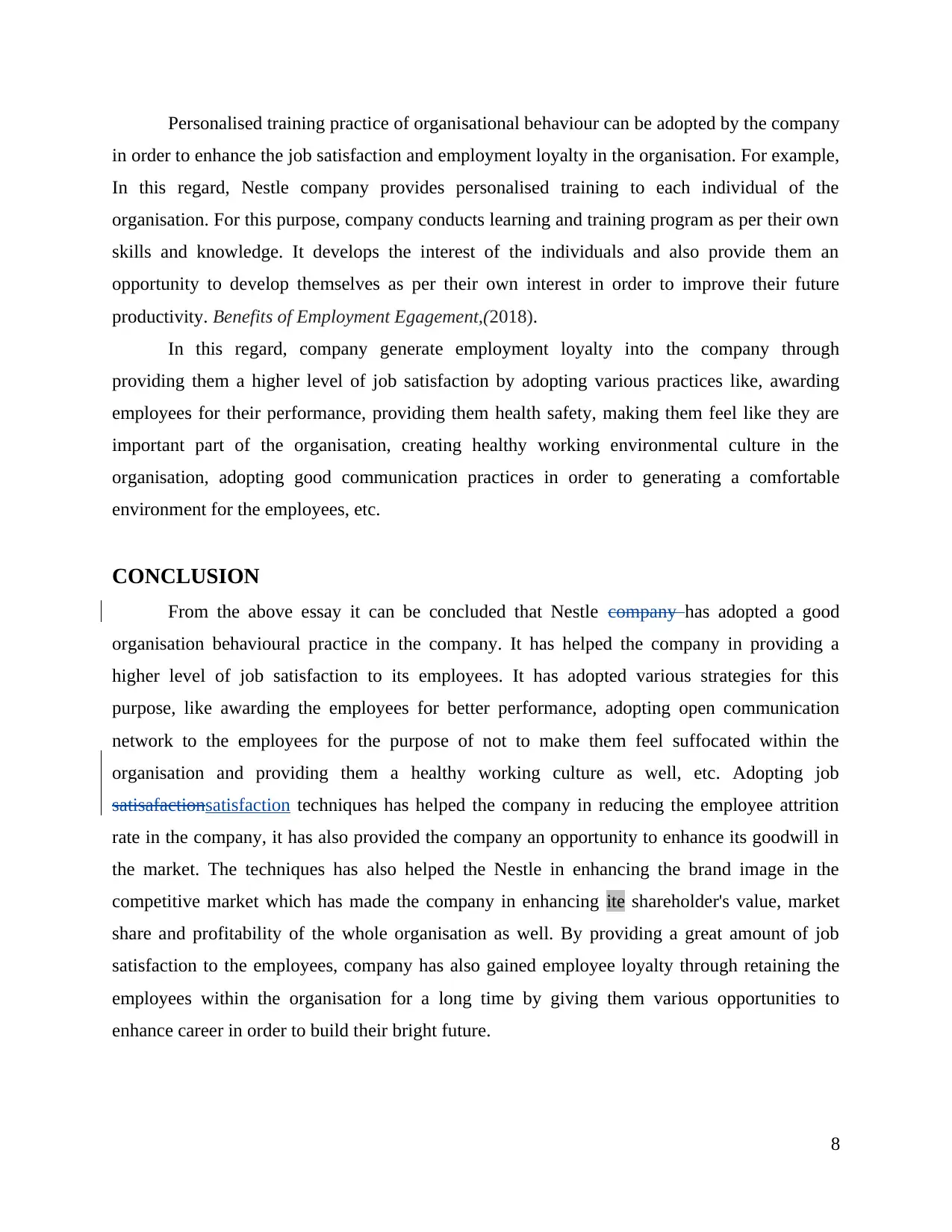
Personalised training practice of organisational behaviour can be adopted by the company
in order to enhance the job satisfaction and employment loyalty in the organisation. For example,
In this regard, Nestle company provides personalised training to each individual of the
organisation. For this purpose, company conducts learning and training program as per their own
skills and knowledge. It develops the interest of the individuals and also provide them an
opportunity to develop themselves as per their own interest in order to improve their future
productivity. Benefits of Employment Egagement,(2018).
In this regard, company generate employment loyalty into the company through
providing them a higher level of job satisfaction by adopting various practices like, awarding
employees for their performance, providing them health safety, making them feel like they are
important part of the organisation, creating healthy working environmental culture in the
organisation, adopting good communication practices in order to generating a comfortable
environment for the employees, etc.
CONCLUSION
From the above essay it can be concluded that Nestle company has adopted a good
organisation behavioural practice in the company. It has helped the company in providing a
higher level of job satisfaction to its employees. It has adopted various strategies for this
purpose, like awarding the employees for better performance, adopting open communication
network to the employees for the purpose of not to make them feel suffocated within the
organisation and providing them a healthy working culture as well, etc. Adopting job
satisafactionsatisfaction techniques has helped the company in reducing the employee attrition
rate in the company, it has also provided the company an opportunity to enhance its goodwill in
the market. The techniques has also helped the Nestle in enhancing the brand image in the
competitive market which has made the company in enhancing ite shareholder's value, market
share and profitability of the whole organisation as well. By providing a great amount of job
satisfaction to the employees, company has also gained employee loyalty through retaining the
employees within the organisation for a long time by giving them various opportunities to
enhance career in order to build their bright future.
8
in order to enhance the job satisfaction and employment loyalty in the organisation. For example,
In this regard, Nestle company provides personalised training to each individual of the
organisation. For this purpose, company conducts learning and training program as per their own
skills and knowledge. It develops the interest of the individuals and also provide them an
opportunity to develop themselves as per their own interest in order to improve their future
productivity. Benefits of Employment Egagement,(2018).
In this regard, company generate employment loyalty into the company through
providing them a higher level of job satisfaction by adopting various practices like, awarding
employees for their performance, providing them health safety, making them feel like they are
important part of the organisation, creating healthy working environmental culture in the
organisation, adopting good communication practices in order to generating a comfortable
environment for the employees, etc.
CONCLUSION
From the above essay it can be concluded that Nestle company has adopted a good
organisation behavioural practice in the company. It has helped the company in providing a
higher level of job satisfaction to its employees. It has adopted various strategies for this
purpose, like awarding the employees for better performance, adopting open communication
network to the employees for the purpose of not to make them feel suffocated within the
organisation and providing them a healthy working culture as well, etc. Adopting job
satisafactionsatisfaction techniques has helped the company in reducing the employee attrition
rate in the company, it has also provided the company an opportunity to enhance its goodwill in
the market. The techniques has also helped the Nestle in enhancing the brand image in the
competitive market which has made the company in enhancing ite shareholder's value, market
share and profitability of the whole organisation as well. By providing a great amount of job
satisfaction to the employees, company has also gained employee loyalty through retaining the
employees within the organisation for a long time by giving them various opportunities to
enhance career in order to build their bright future.
8
Paraphrase This Document
Need a fresh take? Get an instant paraphrase of this document with our AI Paraphraser
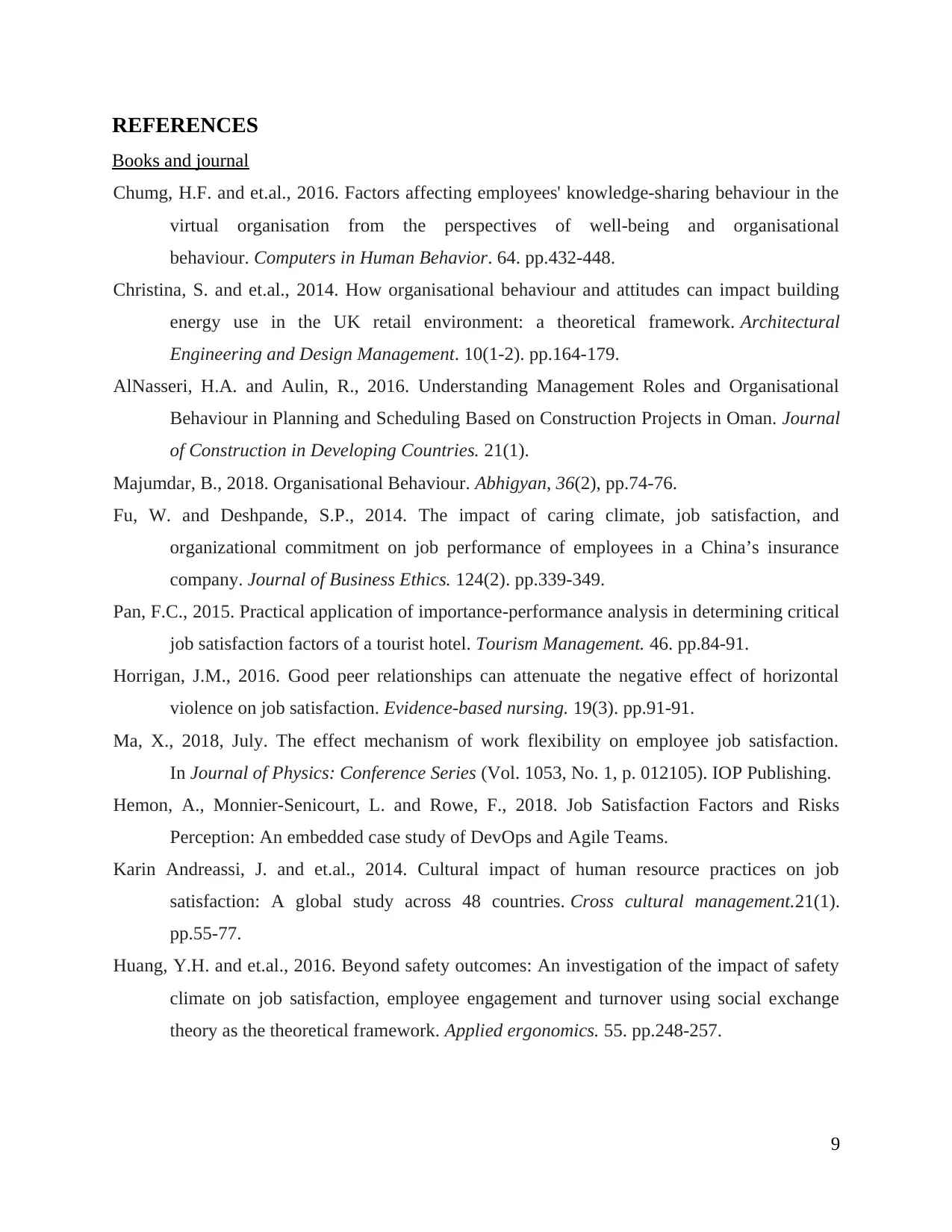
REFERENCES
Books and journal
Chumg, H.F. and et.al., 2016. Factors affecting employees' knowledge-sharing behaviour in the
virtual organisation from the perspectives of well-being and organisational
behaviour. Computers in Human Behavior. 64. pp.432-448.
Christina, S. and et.al., 2014. How organisational behaviour and attitudes can impact building
energy use in the UK retail environment: a theoretical framework. Architectural
Engineering and Design Management. 10(1-2). pp.164-179.
AlNasseri, H.A. and Aulin, R., 2016. Understanding Management Roles and Organisational
Behaviour in Planning and Scheduling Based on Construction Projects in Oman. Journal
of Construction in Developing Countries. 21(1).
Majumdar, B., 2018. Organisational Behaviour. Abhigyan, 36(2), pp.74-76.
Fu, W. and Deshpande, S.P., 2014. The impact of caring climate, job satisfaction, and
organizational commitment on job performance of employees in a China’s insurance
company. Journal of Business Ethics. 124(2). pp.339-349.
Pan, F.C., 2015. Practical application of importance-performance analysis in determining critical
job satisfaction factors of a tourist hotel. Tourism Management. 46. pp.84-91.
Horrigan, J.M., 2016. Good peer relationships can attenuate the negative effect of horizontal
violence on job satisfaction. Evidence-based nursing. 19(3). pp.91-91.
Ma, X., 2018, July. The effect mechanism of work flexibility on employee job satisfaction.
In Journal of Physics: Conference Series (Vol. 1053, No. 1, p. 012105). IOP Publishing.
Hemon, A., Monnier-Senicourt, L. and Rowe, F., 2018. Job Satisfaction Factors and Risks
Perception: An embedded case study of DevOps and Agile Teams.
Karin Andreassi, J. and et.al., 2014. Cultural impact of human resource practices on job
satisfaction: A global study across 48 countries. Cross cultural management.21(1).
pp.55-77.
Huang, Y.H. and et.al., 2016. Beyond safety outcomes: An investigation of the impact of safety
climate on job satisfaction, employee engagement and turnover using social exchange
theory as the theoretical framework. Applied ergonomics. 55. pp.248-257.
9
Books and journal
Chumg, H.F. and et.al., 2016. Factors affecting employees' knowledge-sharing behaviour in the
virtual organisation from the perspectives of well-being and organisational
behaviour. Computers in Human Behavior. 64. pp.432-448.
Christina, S. and et.al., 2014. How organisational behaviour and attitudes can impact building
energy use in the UK retail environment: a theoretical framework. Architectural
Engineering and Design Management. 10(1-2). pp.164-179.
AlNasseri, H.A. and Aulin, R., 2016. Understanding Management Roles and Organisational
Behaviour in Planning and Scheduling Based on Construction Projects in Oman. Journal
of Construction in Developing Countries. 21(1).
Majumdar, B., 2018. Organisational Behaviour. Abhigyan, 36(2), pp.74-76.
Fu, W. and Deshpande, S.P., 2014. The impact of caring climate, job satisfaction, and
organizational commitment on job performance of employees in a China’s insurance
company. Journal of Business Ethics. 124(2). pp.339-349.
Pan, F.C., 2015. Practical application of importance-performance analysis in determining critical
job satisfaction factors of a tourist hotel. Tourism Management. 46. pp.84-91.
Horrigan, J.M., 2016. Good peer relationships can attenuate the negative effect of horizontal
violence on job satisfaction. Evidence-based nursing. 19(3). pp.91-91.
Ma, X., 2018, July. The effect mechanism of work flexibility on employee job satisfaction.
In Journal of Physics: Conference Series (Vol. 1053, No. 1, p. 012105). IOP Publishing.
Hemon, A., Monnier-Senicourt, L. and Rowe, F., 2018. Job Satisfaction Factors and Risks
Perception: An embedded case study of DevOps and Agile Teams.
Karin Andreassi, J. and et.al., 2014. Cultural impact of human resource practices on job
satisfaction: A global study across 48 countries. Cross cultural management.21(1).
pp.55-77.
Huang, Y.H. and et.al., 2016. Beyond safety outcomes: An investigation of the impact of safety
climate on job satisfaction, employee engagement and turnover using social exchange
theory as the theoretical framework. Applied ergonomics. 55. pp.248-257.
9
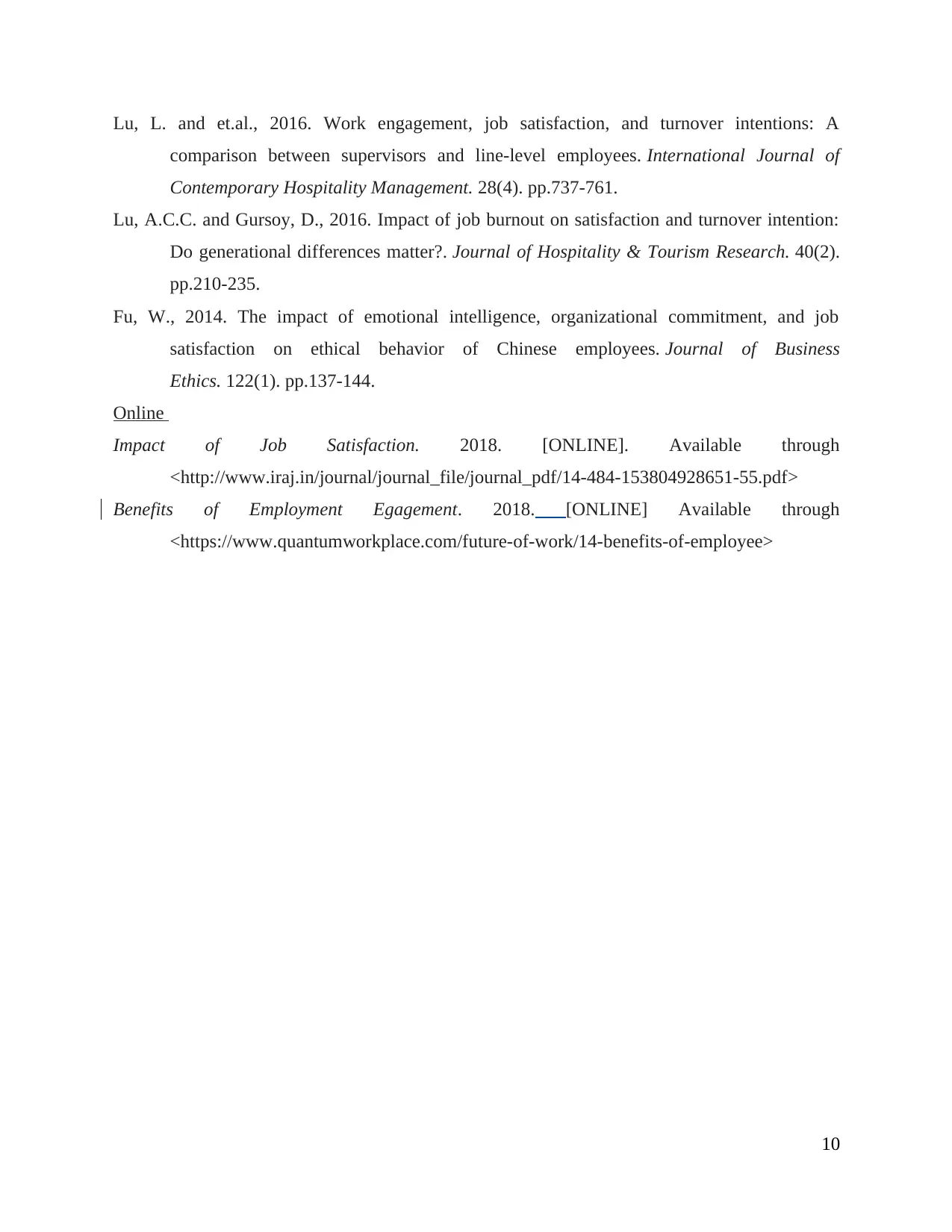
Lu, L. and et.al., 2016. Work engagement, job satisfaction, and turnover intentions: A
comparison between supervisors and line-level employees. International Journal of
Contemporary Hospitality Management. 28(4). pp.737-761.
Lu, A.C.C. and Gursoy, D., 2016. Impact of job burnout on satisfaction and turnover intention:
Do generational differences matter?. Journal of Hospitality & Tourism Research. 40(2).
pp.210-235.
Fu, W., 2014. The impact of emotional intelligence, organizational commitment, and job
satisfaction on ethical behavior of Chinese employees. Journal of Business
Ethics. 122(1). pp.137-144.
Online
Impact of Job Satisfaction. 2018. [ONLINE]. Available through
<http://www.iraj.in/journal/journal_file/journal_pdf/14-484-153804928651-55.pdf>
Benefits of Employment Egagement. 2018. [ONLINE] Available through
<https://www.quantumworkplace.com/future-of-work/14-benefits-of-employee>
10
comparison between supervisors and line-level employees. International Journal of
Contemporary Hospitality Management. 28(4). pp.737-761.
Lu, A.C.C. and Gursoy, D., 2016. Impact of job burnout on satisfaction and turnover intention:
Do generational differences matter?. Journal of Hospitality & Tourism Research. 40(2).
pp.210-235.
Fu, W., 2014. The impact of emotional intelligence, organizational commitment, and job
satisfaction on ethical behavior of Chinese employees. Journal of Business
Ethics. 122(1). pp.137-144.
Online
Impact of Job Satisfaction. 2018. [ONLINE]. Available through
<http://www.iraj.in/journal/journal_file/journal_pdf/14-484-153804928651-55.pdf>
Benefits of Employment Egagement. 2018. [ONLINE] Available through
<https://www.quantumworkplace.com/future-of-work/14-benefits-of-employee>
10
⊘ This is a preview!⊘
Do you want full access?
Subscribe today to unlock all pages.

Trusted by 1+ million students worldwide
1 out of 12
Related Documents
Your All-in-One AI-Powered Toolkit for Academic Success.
+13062052269
info@desklib.com
Available 24*7 on WhatsApp / Email
![[object Object]](/_next/static/media/star-bottom.7253800d.svg)
Unlock your academic potential
Copyright © 2020–2025 A2Z Services. All Rights Reserved. Developed and managed by ZUCOL.





